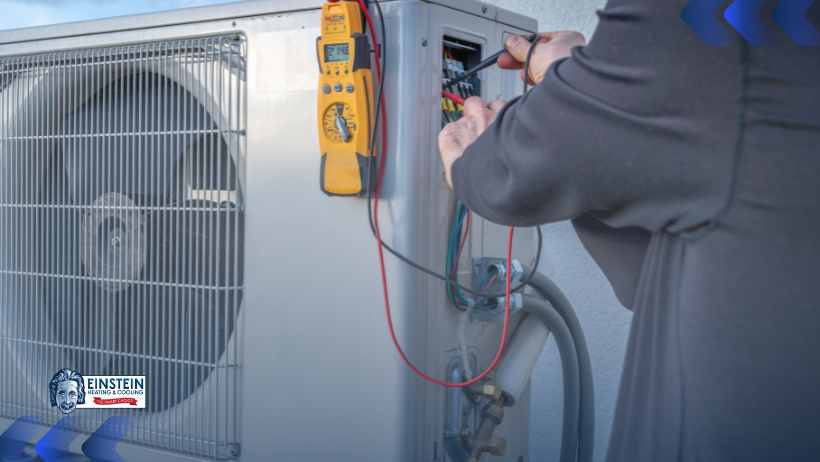When it comes to choosing the right cooling system for your home, the decision often boils down to mini split vs central air. Both systems have their advantages and drawbacks, and understanding the key factors can help you make an informed choice based on your specific needs and preferences.
What is A Mini Split?
A mini-split system, also known as a ductless mini-split or ductless heat pump, operates on the principles of refrigeration to provide both heating and cooling for indoor spaces. Unlike traditional HVAC systems that rely on ductwork to distribute air, mini splits consist of two main components: an indoor unit and an outdoor condenser. Here’s a step-by-step breakdown of how a mini-split system works:
Indoor Unit:
- The indoor unit is installed inside the room or area that requires heating or cooling.
- It typically consists of an evaporator coil, a fan, and controls for temperature adjustments.
- In some models, the indoor unit may also include advanced features such as air filters for improved indoor air quality.
Outdoor Condenser:
- The outdoor condenser unit is installed outside the building, often on a wall, rooftop, or on the ground.
- It houses the compressor, condenser coil, and a fan.
- The compressor is a crucial component that pressurizes and circulates the refrigerant between the indoor and outdoor units.
Refrigerant Circulation:
- The mini-split system uses a closed-loop refrigeration cycle to transfer heat between the indoor and outdoor units.
- Refrigerant, a special fluid with properties that allow it to absorb and release heat efficiently, circulates through the system.
- The refrigerant undergoes phase changes from a low-pressure gas to a high-pressure liquid and back again, facilitating the absorption and release of heat.
Cooling Mode:
- In cooling mode, the indoor unit’s evaporator coil absorbs heat from the indoor air.
- The absorbed heat is then transferred to the refrigerant, causing it to evaporate into a low-pressure gas.
- This process cools the indoor air, and the fan in the indoor unit circulates the cooled air back into the room.
Heating Mode:
- In heating mode, the mini-split system reverses the refrigeration cycle.
- The outdoor unit’s coil acts as an evaporator, absorbing heat from the outside air.
- The absorbed heat is then transferred to the refrigerant, causing it to evaporate into a low-pressure gas.
- The compressor pressurizes the gas, and the heated refrigerant is circulated to the indoor unit.
- The indoor unit’s coil acts as a condenser, releasing the heat into the indoor air, thereby warming the room.
Zoning and Temperature Control:
- One of the key advantages of mini-splits is the ability to create individual climate zones.
- Each indoor unit can be independently controlled, allowing users to set different temperatures for various rooms or areas.
- This zoning flexibility not only enhances comfort but also contributes to energy efficiency by conditioning only the spaces in use.
Factors to Consider When Choosing Mini Split vs Central Air
Installation and Setup
Mini Split Systems
- Mini split systems are known for their ease of installation. These systems consist of an indoor unit and an outdoor condenser connected by a small conduit, requiring only a three-inch hole in the wall for installation. This makes them a flexible and convenient option, especially for homes without existing ductwork. DIY enthusiasts can even tackle the installation themselves with some basic knowledge.
Central Air Systems
- When comparing mini split vs central air, central A/C typically requires professional installation due to the extensive ductwork involved. This process can be more time-consuming and may result in higher installation costs. However, central air is often the preferred choice for larger homes with existing duct infrastructure.
Cost Considerations
Mini Split Systems
- Mini-split systems are generally more cost-effective than central air systems, both in terms of initial investment and ongoing operational costs. The simplicity of the mini split installation process contributes to the lower upfront expenses, making mini-splits an attractive option for budget-conscious homeowners.
Central Air Systems
- Central air systems tend to have higher upfront costs, primarily due to the need for professional installation and ductwork. However, they may offer long-term cost savings in terms of energy efficiency and maintenance, making them a viable choice for those willing to make a larger initial investment.
Energy Efficiency
Mini Split Systems
- Mini split systems are renowned for their energy efficiency. Because they operate on a zone-based system, you can cool specific areas of your home as needed, avoiding the energy waste associated with cooling the entire house when only a few rooms are occupied. Additionally, many mini-split models come with energy-saving features such as programmable thermostats and inverter technology.
Central Air Systems
- A central A/C can be less energy-efficient than mini splits, especially if the ductwork is not properly sealed or insulated. However, advancements in technology have led to more energy-efficient central air systems with features like variable-speed air handlers and smart thermostats, helping to mitigate energy consumption.
Flexibility and Zoning
Mini Split Systems
- One of the standout features of a split AC unit is its ability to provide unique zoning systems. Each indoor unit can be controlled independently, allowing for customized temperature settings in different areas of the home. This level of flexibility is ideal for households where occupants have varying temperature preferences.
Central Air Systems
- Central air systems traditionally operate on a single thermostat, controlling the temperature for the entire house. While advancements such as zoning systems are available for central air, they often require additional installation and cost. Mini-splits have a natural advantage in this regard.
Aesthetics and Space Utilization
Mini Split Systems
- Mini split indoor units are sleek and compact, making them a visually appealing choice for homeowners who prioritize aesthetics. These units can be mounted high on walls, recessed into ceilings, or even concealed in furniture, offering a range of options for integrating them seamlessly into your home’s design.
Central Air Systems
- When comparing central air vs mini split, central air systems, by contrast, rely on a single central unit and a network of ducts that can be installed by HVAC technicians. While modern designs have improved the aesthetics of central air units, they still require dedicated space for the central air handler, and the ductwork can impact the visual appeal of a home.
Noise Levels
Mini Split Systems
- Mini split systems are known for their quiet operation. The noisy components, such as the compressor and condenser, are located outside the house. This ensures that indoor units generate minimal noise, providing a comfortable and quiet living environment.
Central Air Systems
- Central air systems can be noisier, especially if the air handler is located inside the home. While advancements in technology have led to quieter central air units, the noise factor remains a consideration for those who prioritize a silent cooling experience.

Maintenance Requirements
Mini Split Systems
- Mini-split systems generally have lower maintenance requirements. Regular cleaning of air filters and occasional professional check-ups are usually sufficient to keep the system running smoothly. The absence of ductwork also means there’s less opportunity for dust and debris buildup.
Central Air Systems
- Central air systems may require more maintenance due to the extensive ductwork. Ducts should be inspected and cleaned regularly to ensure optimal performance and indoor air quality. Additionally, the central air unit may need more comprehensive professional maintenance.
Long-Term Durability
Mini Split Systems
- Mini split systems are known for their durability and longevity. With proper maintenance, these systems can provide reliable cooling for many years. The simplicity of the design, with fewer moving parts, contributes to their overall durability.
Central Air Systems
- When comparing central air vs mini split, central air systems are also designed to be durable, but the lifespan can be influenced by factors such as the quality of installation, regular maintenance, and the overall efficiency of the system. Investing in a high-quality central air system and professional installation by expert HVAC technicians can enhance its long-term durability.
Climate Considerations
Mini Split Systems
- Mini split systems are highly versatile and suitable for various climates. They excel in both cooling and heating, making them an all-season solution. Some models are designed to operate efficiently in extreme temperatures, ensuring comfort year-round.
Central Air Systems
- Central air systems are effective in moderate climates, but they may face challenges in extremely hot or cold environments. Proper insulation and system sizing are crucial for optimizing central air performance in different climate conditions to avoid costly central air repair.
Environmental Impact
Mini Split Systems
- Mini-split systems are considered more environmentally friendly due to their energy efficiency. The zoning capability reduces energy waste, and the use of R-410A refrigerant, which has a lower impact on the ozone layer, contributes to a smaller carbon footprint.
Central Air Systems
- Central air systems have made strides in improving environmental impact, with many models now using environmentally friendly refrigerants. However, the energy efficiency of central air systems can vary, and their overall impact may depend on factors such as system size and usage patterns.
Return on Investment
Mini Split Systems
- Mini split systems often offer a quicker return on investment, given their lower upfront costs and energy-efficient operation. The potential energy savings can contribute to long-term financial benefits, making the initial investment in a mini split system a wise financial decision for many homeowners.
Central Air Systems
- While central air systems may have a higher initial cost, their return on investment can be substantial over time, particularly if the system is energy-efficient and well-maintained. Homeowners should carefully assess their budget constraints and long-term financial goals when considering the return on investment for central air.
Integration with Smart Technology
Mini Split Systems
- Many modern mini-split systems come equipped with smart technology features, allowing homeowners to control the smart thermostat remotely via smartphone apps or integrate them with home automation systems. This level of convenience and control can be a significant advantage for those who value the latest technological advancements.
Central Air Systems
- Central air systems have also embraced smart technology, with the availability of programmable thermostats and Wi-Fi-enabled control options. While not all central air systems come with these features, retrofitting is often possible, providing homeowners with the ability to upgrade their system to a smart and connected environment.
Initial Cool Down Time
Mini Split Systems
- A split AC unit typically offers faster cooling in individual zones due to its direct control over specific areas. The absence of ducts means that cool air can be delivered directly, reducing the time it takes to achieve the desired temperature in a particular room.
Central Air Systems
- Central air systems may take longer to cool down a home, especially in larger houses where the air has to travel through extensive ductwork. However, once the desired temperature is reached, central air systems can maintain a consistent climate throughout the entire house.
Retrofitting and Upgrading
Mini Split Systems
- Mini split systems are well-suited for retrofitting and upgrading, making them an excellent choice for older homes without existing ductwork. Homeowners can easily add more indoor units or upgrade their systems to accommodate changing needs without major renovations.
Central Air Systems
- Retrofitting central air systems can be more challenging and may involve significant construction work to install ductwork. While upgrading central air units or incorporating zoning systems is possible, the process may be more complex and costly compared to mini-split systems. If you’re looking for location-specific HVAC technicians in Arizona, make sure to contact reputable pros in your area.
Warranty and Support
Mini Split Systems
- The warranty and support for mini split systems can vary among manufacturers. It’s essential to research and choose a reputable brand that offers a comprehensive warranty and reliable customer support. Pay attention to the terms and conditions, including coverage for both parts and labor.
Central Air Systems
- Similar to mini split systems, the warranty and support for central air systems depend on the manufacturer. Investing in a high-quality system from a reputable brand is crucial to ensure adequate coverage and support in case of any issues.
Conclusion
While mini-split systems offer flexibility, energy efficiency, and easy installation, central air systems provide centralized control and may be more suitable for larger homes with existing ductwork. Carefully assess the factors mentioned above, considering your budget, climate, and long-term goals to make an informed decision that aligns with your specific needs. Make sure to trust only experienced and certified HVAC technicians from Einstein Heating and Cooling for your HVAC needs.








